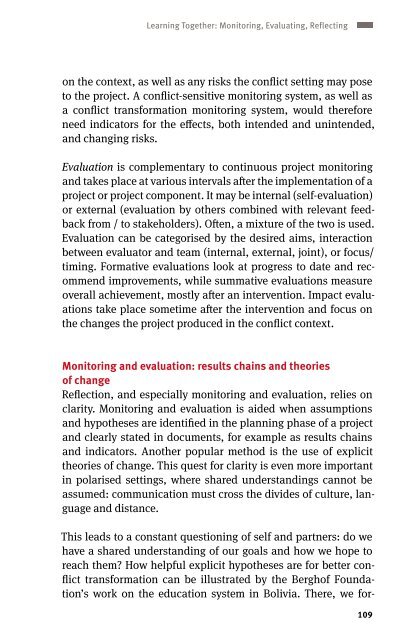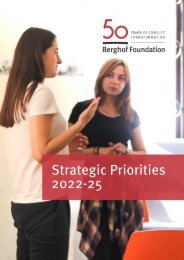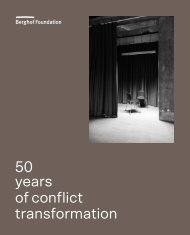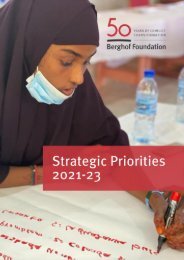Berghof Glossary on Conflict Transformation
The Berghof Glossary on Conflict Transformation presents 20 of the main principles and approaches used by the Berghof Foundation in its work. It is a concise and accessible exploration of what it takes to create “space for conflict transformation”. 2019 edition.
The Berghof Glossary on Conflict Transformation presents 20 of the main principles and approaches used by the Berghof Foundation in its work. It is a concise and accessible exploration of what it takes to create “space for conflict transformation”. 2019 edition.
You also want an ePaper? Increase the reach of your titles
YUMPU automatically turns print PDFs into web optimized ePapers that Google loves.
Learning Together: M<strong>on</strong>itoring, Evaluating, Reflecting<br />
<strong>on</strong> the c<strong>on</strong>text, as well as any risks the c<strong>on</strong>flict setting may pose<br />
to the project. A c<strong>on</strong>flict-sensitive m<strong>on</strong>itoring system, as well as<br />
a c<strong>on</strong>flict transformati<strong>on</strong> m<strong>on</strong>itoring system, would therefore<br />
need indicators for the effects, both intended and unintended,<br />
and changing risks.<br />
Evaluati<strong>on</strong> is complementary to c<strong>on</strong>tinuous project m<strong>on</strong>itoring<br />
and takes place at various intervals after the implementati<strong>on</strong> of a<br />
project or project comp<strong>on</strong>ent. It may be internal (self-evaluati<strong>on</strong>)<br />
or external (evaluati<strong>on</strong> by others combined with relevant feedback<br />
from / to stakeholders). Often, a mixture of the two is used.<br />
Evaluati<strong>on</strong> can be categorised by the desired aims, interacti<strong>on</strong><br />
between evaluator and team (internal, external, joint), or focus/<br />
timing. Formative evaluati<strong>on</strong>s look at progress to date and recommend<br />
improvements, while summative evaluati<strong>on</strong>s measure<br />
overall achievement, mostly after an interventi<strong>on</strong>. Impact evaluati<strong>on</strong>s<br />
take place sometime after the interventi<strong>on</strong> and focus <strong>on</strong><br />
the changes the project produced in the c<strong>on</strong>flict c<strong>on</strong>text.<br />
M<strong>on</strong>itoring and evaluati<strong>on</strong>: results chains and theories<br />
of change<br />
Reflecti<strong>on</strong>, and especially m<strong>on</strong>itoring and evaluati<strong>on</strong>, relies <strong>on</strong><br />
clarity. M<strong>on</strong>itoring and evaluati<strong>on</strong> is aided when assumpti<strong>on</strong>s<br />
and hypotheses are identified in the planning phase of a project<br />
and clearly stated in documents, for example as results chains<br />
and indicators. Another popular method is the use of explicit<br />
theories of change. This quest for clarity is even more important<br />
in polarised settings, where shared understandings cannot be<br />
assumed: communicati<strong>on</strong> must cross the divides of culture, language<br />
and distance.<br />
This leads to a c<strong>on</strong>stant questi<strong>on</strong>ing of self and partners: do we<br />
have a shared understanding of our goals and how we hope to<br />
reach them? How helpful explicit hypotheses are for better c<strong>on</strong>flict<br />
transformati<strong>on</strong> can be illustrated by the <str<strong>on</strong>g>Berghof</str<strong>on</strong>g> Foundati<strong>on</strong>’s<br />
work <strong>on</strong> the educati<strong>on</strong> system in Bolivia. There, we for-<br />
109










